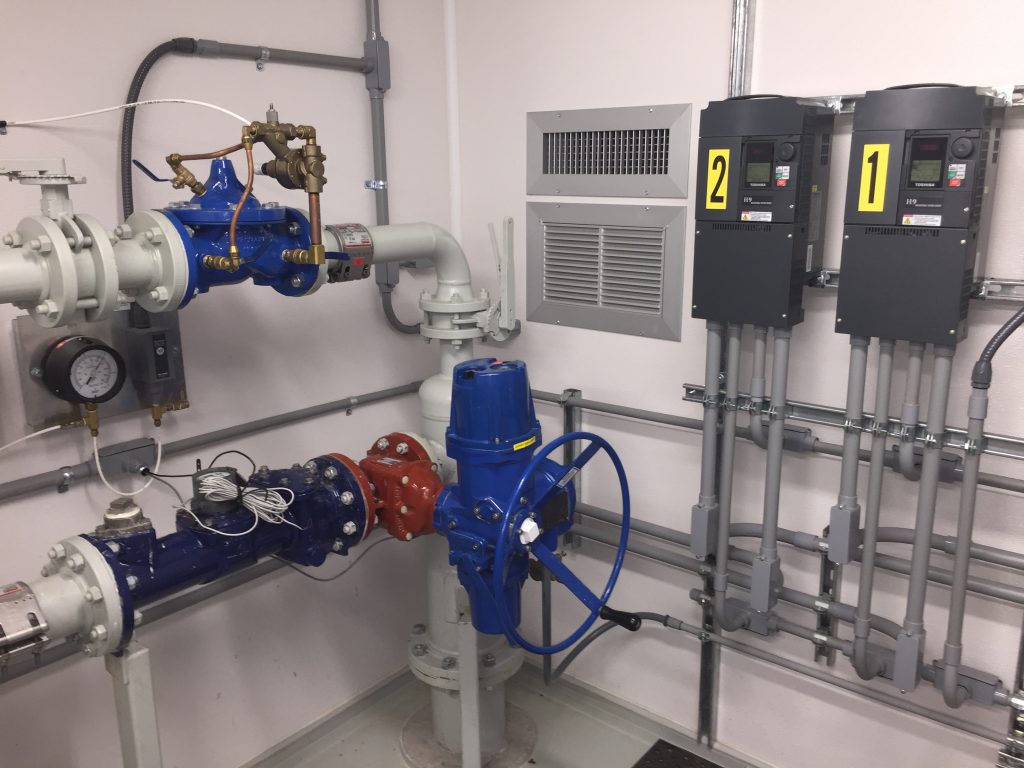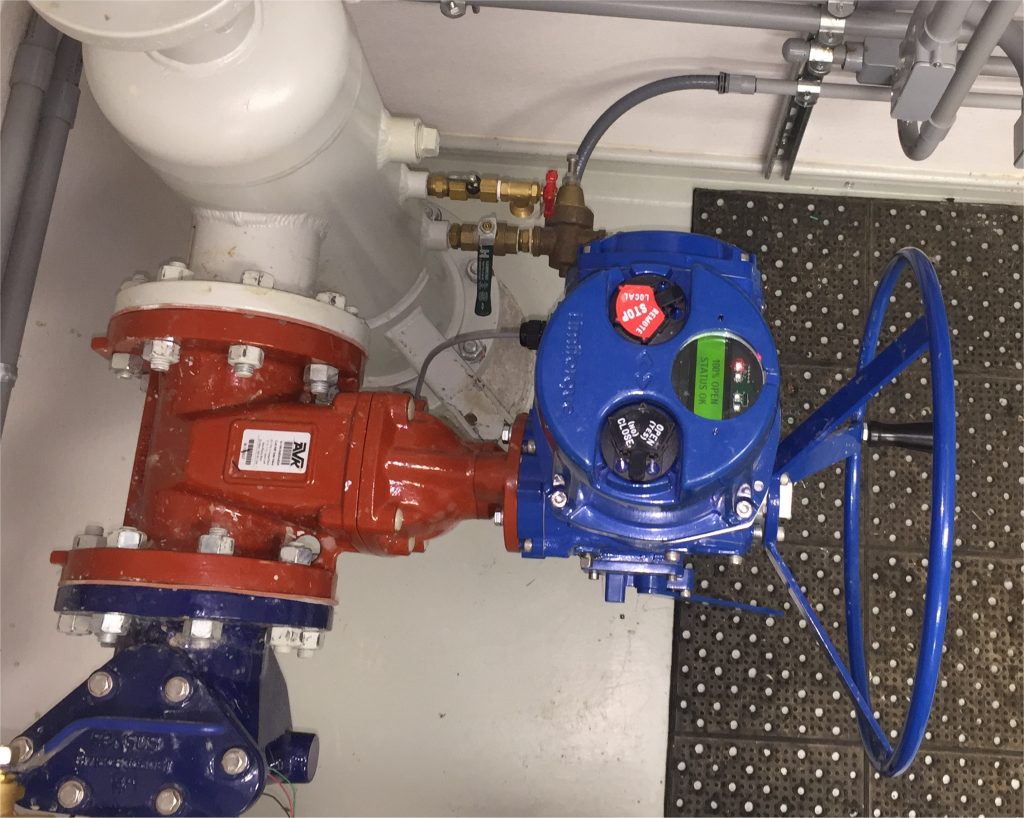Valve Automation at Potable Water Districts
Valve Automation serves a vital role in Potable Water Telemetry Control System Integration. Valves are used in a variety of applications, which broadly include OPEN/CLOSE applications for ON/OFF flow control, as well as MODULATING applications for variable pressure and flow control.
Jim Mimlitz, NRI
This article will address an interesting problem that we recently solved through Valve Automation. One of our newest clients has a distribution infrastructure that consists of an Elevated Tank in the middle of the town; and the overall distribution system is fed by a Booster Pump Station approximately 3 miles outside of town. The Booster Pump Station is the custody transfer point where bulk water is purchased from a larger nearby city.
The pump station is outfitted with two 15 HP booster pumps, two VFDs, and a wireless telemetry system that controls the pumps based upon remote elevated tank level readings acquired via telemetry. The bulk water supplier provides water pressure that is sufficient to gravity feed water through the station, as well — typically at a flow rate of 40 GPM.
The influent pressure was not so high that the elevated tank would overflow — However, during periods when the pumps were OFF, the relatively constant gravity free-flow prevented the level of water in the elevated tank from drawing low enough to turnover/refresh the water in the tank.
In order to allow the water level in the tank to draw down further, it was desirable to shut OFF the free-flow whenever the pumps were OFF. This could be accomplished by retrofitting an existing isolation gate valve in the station with a telemetry-controlled, OPEN/CLOSE electric actuator.

On the Influent Side of the Station, There Existed a Manual Gate Valve Which Could Be Automated To Inhibit Free-Flow.
The existing 4 inch AWWA-type gate valve on the influent pipe was an excellent candidate for retrofit controls to inhibit free-flow. The original valve had a handwheel actuator, which would need to be removed and replaced with a mounting plate for an electric actuator. However, based on analysis of all factors, the approach with the lowest cost, risk, and down-town consisted of acquiring a replacement AWWA-style gate valve (identical lay-length) with the proper mounting hardware — rather than attempt to remove and retrofit the existing valve.
Extensive research led us to American AVK (Minden, NV), a US-based manufacturer who produces a full line of AWWA-type gate valves. American AVK especially stood out due to their flexibility and their ability to quickly and economically provide a valve with an industry-standard FA-10 mounting plate/actuator interface via their local distributor, HD Supply Waterworks.

American AVK Gate Valve. 4 Inch Size. FA-10 Electric Actuator Mounting Interface + Stem.
Once in-hand, the gate valve was mated to a Limitorque MX-10 Electric, Multi-Turn Actuator by our Valve Automation Partner Mead O’Brien (St. Louis, MO). Then, the complete Valve/Actuator assembly was field-installed by the Water District’s Contract Operator, Consolidated Water Service (Centralia, IL); and telemetry integration was completed by Navionics Research.

Complete Valve/Actuator Assembly, Before Installation.

Complete Valve/Actuator Assembly, After Installation and Telemetry Integration.

Valve and Actuator. Top View.
Performance Before Valve Automation:
Above: 24-Hour History Chart Before Valve Automation: Pump ON/OFF Status.

Above: 24-Hour History Chart Before Valve Automation: Flow Rate (GPM). Note the Presence of Free-Flow When Pumps OFF.
Performance After Valve Automation:
Above: 24-Hour History Chart After Valve Automation: Pump ON/OFF Status.
Above: 24-Hour History Chart After Valve Automation: Valve OPEN Status. Note the Valve Is Open When Pump is ON.
Above: 24-Hour History Chart After Valve Automation: Valve CLOSED Status. Note the Valve Is Closed When Pump is OFF.

Above: 24-Hour History Chart After Valve Automation: Flow Rate (GPM). Note the Absence of Free-Flow When Pump is OFF.
The project was a total success. Free-flow was inhibited during pump OFF cycles, allowing the water level in the elevated tank to draw down lower and refresh, which assists the Water District in maintaining target chlorine residuals.
It is important to note that projects such as this could also be accomplished with a butterfly valve and a quarter-turn electric actuator. However, in this instance, the most convenient valve in the station was an existing gate valve.
Special thanks go out to our partners for their expertise and excellent support. At Consolidated Water Service — Jason Green; at American AVK — Territory Manager Josh Lindsey and VP Engineering Services John Wilber; at HD Supply Waterworks — James Casteel; and at Mead O’Brien Vicki Hobson.
Valve Automation Can Solve Many Potable Water Production and Distribution Problems
Would our state-of-the-art Valve Control Technology help solve a control challenge in your Water District? Give us a call or send us an email. Our Telemetry/Control Systems are designed to leverage this exciting technology; and we’ll be glad to discuss this with you in further detail.
Telemetry, SCADA, & Controls Newsletter
Was this article helpful? Would you be interested in receiving updates such as these in our occasional email-delivered newsletter? If so, here’s our sign-up page:
Subscribe to Navionics Research’s “Telemetry, SCADA, & Controls Newsletter”
